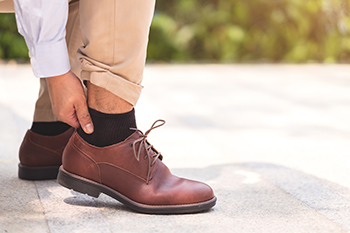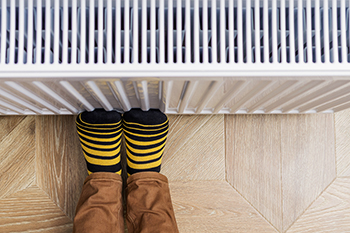Items filtered by date: February 2023
Causes of Bunions

A bunion is a deformity of the big toe where the bottom of the toe bone is pushed outward, forcing the top of the toe to move inward. Bunions are often painful and can have a variety of causes. Top on the list is genetics. Many people may be predestined to have bunions because it runs in the family. Other factors are biomechanics, such as overpronation and flexible joints, which can throw off the alignment in the big toe and the metatarsals. Pregnancy can also be a factor in developing a bunion. A hormone called relaxin can loosen the ligaments in the bones of the feet, causing them to widen as the bones shift in position. Being overweight is another possible cause of bunion formation as extra weight increases the pressure on the big toe, which absorbs most of the force when you walk. Finally, wearing shoes that are too tight or narrow and have pointy toes can increase the severity of a bunion. To find out more about bunions, it is suggested that you contact a chiropodist.
Bunions progressively worsen over time and may cause walking in your shoes to become difficult. To learn more about bunions, please consult with one of the chiropodists from Complete Family Footcare & Therapy. Our clinicians will assess your condition and provide you with quality foot and ankle treatment.
What Are Bunions?
A bunion is a bony bump that protrudes from the base of the big toe. Bunions are caused due to a misalignment of the first metatarsal. The characteristic bump of a bunion forms when the metatarsal shifts outwards from its proper position. Bunions develop slowly over time and progressively worsen without treatment. The skin over the bunion may develop calluses due to the friction from shoes. Eventually, a bunion can make walking uncomfortable or even painful. Bunions are one of the most common foot deformities and are especially common in women and older adults.
Symptoms
A bunion appears as a bulging bump on the outside of the base of the big toe.
The bunion may also:
-
Be swollen, red, or sore
-
Develop corns or calluses over it
-
Cause pain
-
Limit the big toe’s range of motion
Treatment
There are several different treatments available for bunions. Conservative treatment options include wearing shoes with a wider toe box, cushioning the bunion with a specialized pad, wearing shoe inserts, icing the bunion if it becomes inflamed, and taking medications to relieve pain. In more severe cases, more invasive procedures may be done. This may involve removing the swollen tissue around the bunion, straightening the big toe, realigning the bones at the front of the foot, or a combination of these procedures.
If you have any questions, please feel free to contact our offices located in . We offer the newest diagnostic and treatment technologies for all your foot care needs
Working With Foot Pain

People who have professions that require standing for the majority of the day may have foot pain when the day is over. There are several jobs that fall into this category, including the retail industry, restaurant employees, and the medical field. People may experience poor circulation, and it is advised to stretch and elevate the feet as often as possible. Poor circulation may ultimately increase the risk of damage to the cardiovascular system and may be alleviated by walking during the day. It is beneficial to wear shoes and socks that are comfortable, and made of breathable materials. Employers who are aware of how standing affects their employee's feet can offer stress mats to stand on. This is helpful in providing adequate cushioning for the overall body. If you would like more information about helpful tips to protect the feet while working, please schedule an appointment with a chiropodist.
If you stand all day, you may be at an increased risk of developing various foot conditions. If you are experiencing foot pain of any kind, please consult with one of the chiropodists from Complete Family Footcare & Therapy. Our clinicians will assess your condition and provide you with quality foot and ankle treatment.
What Foot Problems Are Caused by Standing?
Standing all day at work may increase your risk of developing foot or ankle problems.
Some common foot conditions that may arise from spending all day on your feet include:
-
Foot pain
-
Blisters
-
Corns and calluses
-
Arthritis
-
Flat feet
-
Bunions
-
Sprains
-
Athlete’s foot
Prevention
If you stand for prolonged periods of time for work, taking preventative measures to preserve the health of your feet is strongly recommended.
Measures you can implement to help prevent foot problems include:
-
Wearing shoes that are comfortable and fit well - these shoes should be made of breathable materials and provide you with arch support and cushioning. It is best to avoid shoes that have heels or narrow toe boxes.
-
Taking breaks to rest, walk, and stretch your feet throughout the day
-
Maintaining good foot hygiene - wash and dry your feet thoroughly every day
If you have any questions, please feel free to contact our offices located in . We offer the newest diagnostic and treatment technologies for all your foot care needs.
Oh, My Aching Feet

With all the things we depend on our feet for, it is understandable that they may become sore and tired now and then. Luckily, most causes of foot pain can be relieved by simple measures, such as maintaining a healthy body weight, doing strength and stretching exercises, and wearing well-fitting shoes. Obesity can cause other health conditions, including stress and strain on the feet. Maintaining a healthy, active lifestyle and a reasonable body weight will improve one's overall health, including the feet. Exercising the feet can assist with stability and flexibility, thereby reducing pain. Make sure the shoes that are worn fit well, provide adequate support for activities performed, and properly support the arches. will also go a long way in increasing the comfort of the feet and keeping pain at bay. If you suffer from obstinate foot pain, medical intervention might be called for. See a chiropodist who can do a thorough examination of your feet and recommend treatment options.
Foot pain is a common problem treated by chiropodists. If you have foot pain, please consult with one of the chiropodists from Complete Family Footcare & Therapy. Our clinicians can help you maintain the health of your lower limbs and your mobility.
When you are experiencing foot pain, it’s important to note the type of pain and its location, as this can help determine a diagnosis.
Pain in the top of the foot may be caused by:
-
Stress fractures
-
Sinus tarsi syndrome
-
Extensor tendonitis
-
Tibialis anterior tendonitis
-
Gout
-
Athlete’s foot
-
Ganglion cysts
Pain in the bottom of the foot may be caused by:
-
Plantar fasciitis
-
Foot cramps
-
Tarsal tunnel syndrome
-
Plantar fibromatosis
-
Posterior tibial tendonitis
-
Stress fractures
-
Flat feet
Pain on the side of the foot may be caused by:
-
Ankle sprain
-
Cuboid syndrome
-
Peroneal tendonitis
-
Stress fractures
-
Bunions
-
Corns or calluses
-
Posterior tibial tendonitis
Heel pain may be caused by:
-
Plantar fasciitis
-
Achilles tendonitis
-
Bone spurs
-
Heel fractures
-
Retrocalcaneal bursitis
-
Sever’s disease
Pain in the toes may be caused by:
-
Gout
-
Hammertoe
-
Turf toe
-
Bunions
-
Ingrown toenails
-
Blisters
-
Arthritis
These and many more conditions can be treated by a chiropodist. If you have any questions, please feel free to contact our offices located in . We offer the newest diagnostic and treatment technologies for all your foot care needs.
Ways to Keep Your Feet Healthy During the Winter Months

Dry, cracked skin on your feet can become worse during the cold, winter months. In addition, the feet are naturally drier than other body parts because they lack the oil glands necessary for hydration. For that reason, a winter foot care routine is suggested as a way to avoid the formation of open cracks on the heels and feet that can turn into fissures. Top on the list of preventing dry, cracked skin on the feet is drinking plenty of water. Dehydration is the primary cause of dry skin. Keeping your feet clean and dry is another method of avoiding dry skin. After soaking or washing your feet in warm water, and making sure they are thoroughly dry, applying a good moisturizer is recommended by experts. Doing this immediately after a shower or bath is optimum, because the pores in the skin are open wider, which allows for increased absorption. Moisturizing your feet before bedtime, and wearing clean socks to keep the moisture contained, are other methods of protecting your skin from drying out. For more information on wintertime skin care practices for your feet, please consult a chiropodist.
Caring for your feet is not just something done at the chiropodist’s office. Good foot care starts at home. If you would like to learn more about daily foot care practices, please consult with one of the chiropodists from Complete Family Footcare & Therapy. Our clinicians can help you maintain the health of your lower limbs and your mobility.
There are many things that you can do at home to help care for your feet, including:
-
Wearing shoes and socks that fit properly
-
Washing the feet daily with soap and water
-
Drying the feet thoroughly
-
Applying moisturizer to the soles and heels of the feet
-
Taking a walk and exercising the feet regularly
-
Doing foot stretches and strengthening exercises
A chiropodist can help figure out a manageable foot care routine for you to keep your feet healthy. If you have any questions, please feel free to contact our offices located in . We offer the newest diagnostic and treatment technologies for all your foot care needs.

